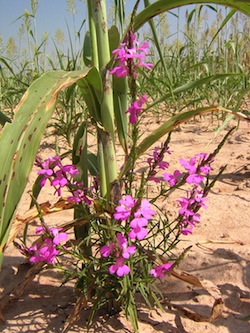 Interesting, and temporally confusing, news item from Wageningen University. Dated 12 January, it tells us that on 11 January Muhammad Jamil will be defending his doctoral research on the very pretty but also very devastating parasitic weed Striga. ((Maybe I just don’t understand the timing of such things as defences and awards in the Dutch system.)) And fascinating research it is too.
Interesting, and temporally confusing, news item from Wageningen University. Dated 12 January, it tells us that on 11 January Muhammad Jamil will be defending his doctoral research on the very pretty but also very devastating parasitic weed Striga. ((Maybe I just don’t understand the timing of such things as defences and awards in the Dutch system.)) And fascinating research it is too.
Striga seeds germinate in response to strigolactones, which are secreted by the host plant’s roots, and which effectively tell the parasite that there is a host nearby. Strigolactones are made from carotenes, which are the precursors of vitamin A, an essential micronutrient for people. Jamil’s research shows that the less carotene a plant produces, the less likely it is to be parasitised by Striga. Jamil also demonstrated considerable differences among rice varieties in the amount of strigalactones they produce under identical conditions.
Which raises lots of lovely questions. Will crops bred for higher levels of carotene — say to improve human nutrition — be more susceptible to Striga parasitism? Is the solution to breed those self-same crops to block the production of strigalactones? Could this be a job for life for high-tech plant breeders? And what’s wrong with the push-pull approach to controlling Striga? Does it, for example, not work on rice?
I do hope Muhammad is now Dr Jamil.